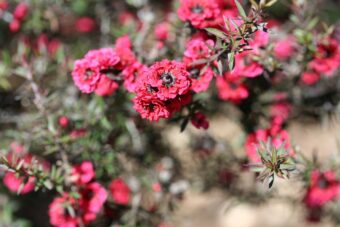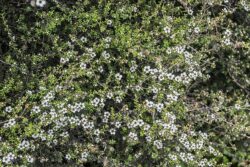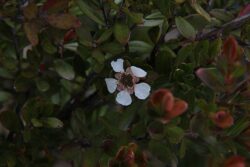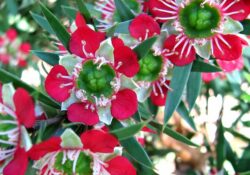In this article, we will talk about how to grow the not so often seen shrub of Leptospermum in containers. Leptospermum is a genus of shrubs and small trees that belongs to the Myrtaceae (Myrtle) family. It has the common name of tea tree, which is often used for species of Melaleuca (where Melaleuca honey comes from). Most, despite their common name, are not found in New Zealand but in Australia, where great diversity can be found. It is not popular as it can be a tender plant and needs the protection of being near a wall.

Plants in the genus are either small prostrating shrubs or small trees that have fibrous, fleshy or papery bark. The leaves are alternately arranged and are relatively small to the size of the shrub. They are aromatic when they are crushed.
The flowers that appear in May or June may be arranged in singles or groups and are either pink, red or white. The flowers have stamens that are shorter than the petals. The blooms are followed by a woody capsule that splits at the tips, releasing the seeds everywhere. In some species, this does not occur until the plant dies or partial dies.
The masses of flowers will be your reward only if you get the growing conditions right, otherwise, it can be a disappointment. The flowers are long-lasting as well, so what more that you can ask for?
Find out how to grow Leptospermum in containers in this article.
GROWING LEPTOSPERMUM IN CONTAINERS
First, choose a large enough container such as a half-sized barrel that has plenty of drainage holes at the bottom. The larger the better for the shrub in question. To the bottom of the container add a 2cm layer of gravel to allow any excess water to drain away. On top of this, create a sandy growing media by mixing 70% by volume of multipurpose compost with 30% by volume of washed building sand.
Create a hole at the centre of the container by digging an aperture slightly bigger than the root ball it came in its original container when you bought it. Drop the plant in so that the top of the root ball is at the same level as the top surface of the compost in the container. Backfill with the growing media so that no vacant spaces remain, using more compost if you deem it to be necessary. Firm the plant in and water well.
THE BEST CARE FOR YOUR LEPTOSPERMUM

This is one plant that will do well in full sun, so find the sunniest spot against a sheltered spot. You will need to water well, whilst the plant is establishing, but once established it will tolerate drought pretty well. In any case, water when 5cm below the top surface of the compost feels dry to the touch, Water until it emerges from the drainage holes at the bottom.
They are not particularly hungry plants but will benefit by giving a slow–release general-purpose fertilizer in spring every year. This will give it all the nutrients it needs to get through the growing season.
Pruning is not necessary but you can cut back damaged and unwanted branches in early spring. You can also cut away any shoots that grow from the base close to the main trunk.
To propagate all you need to do is take semi-ripe cuttings in summer and place them in a cold frame. They should be allowed to grow on for planting out next year.
PESTS AND DISEASES

In the UK, unlike its native Australia, does not suffer from pests and diseases. The only problem is that it is tender and unless you offer the protection of a greenhouse, you will need to place the container in a location where it is protected from cold winds and harsh frosts.
VARIETIES TO GROW
The most common species you will find is Leptospermum scoparium which grows up to 2.5m tall. It is an upright species that normally produces single, white flowers, the variations include ‘Red Danish’ which produces double red flowers and has purple-tinged leaves, ‘Snow Flurry’ has double white flowers, ‘Chapmannii’ produces brightly single pink flowers, whilst ‘Nichollsii’ produces single, red flower and has bronze-purple leaves.

Compact varieties include ‘Nanuk’ and ‘Kiwi’ whilst the most colourful is ‘Spectracolor’ with red-centred white flowers.
An alternative is Leptospermum longiform which is hardier and more compact than L. scoparium. The flowers are the usual white and the variety to grow is ‘Silver Sheen’.
CONCLUSIONS
In this article, we have discussed the not so often seen but beautiful shrub of Leptospermum in containers. They tend to be tender but make up for this defect by producing masses of flowers in late spring, they are easy to care for, easy to look for and great for those who want something of the exotic.
If you want a shrub that others do not have then this is for you.
If you have any questions or comments that you wish to make on growing Leptospermum in containers, please do so in the comment box below.
Happy Leptospermum growing.
